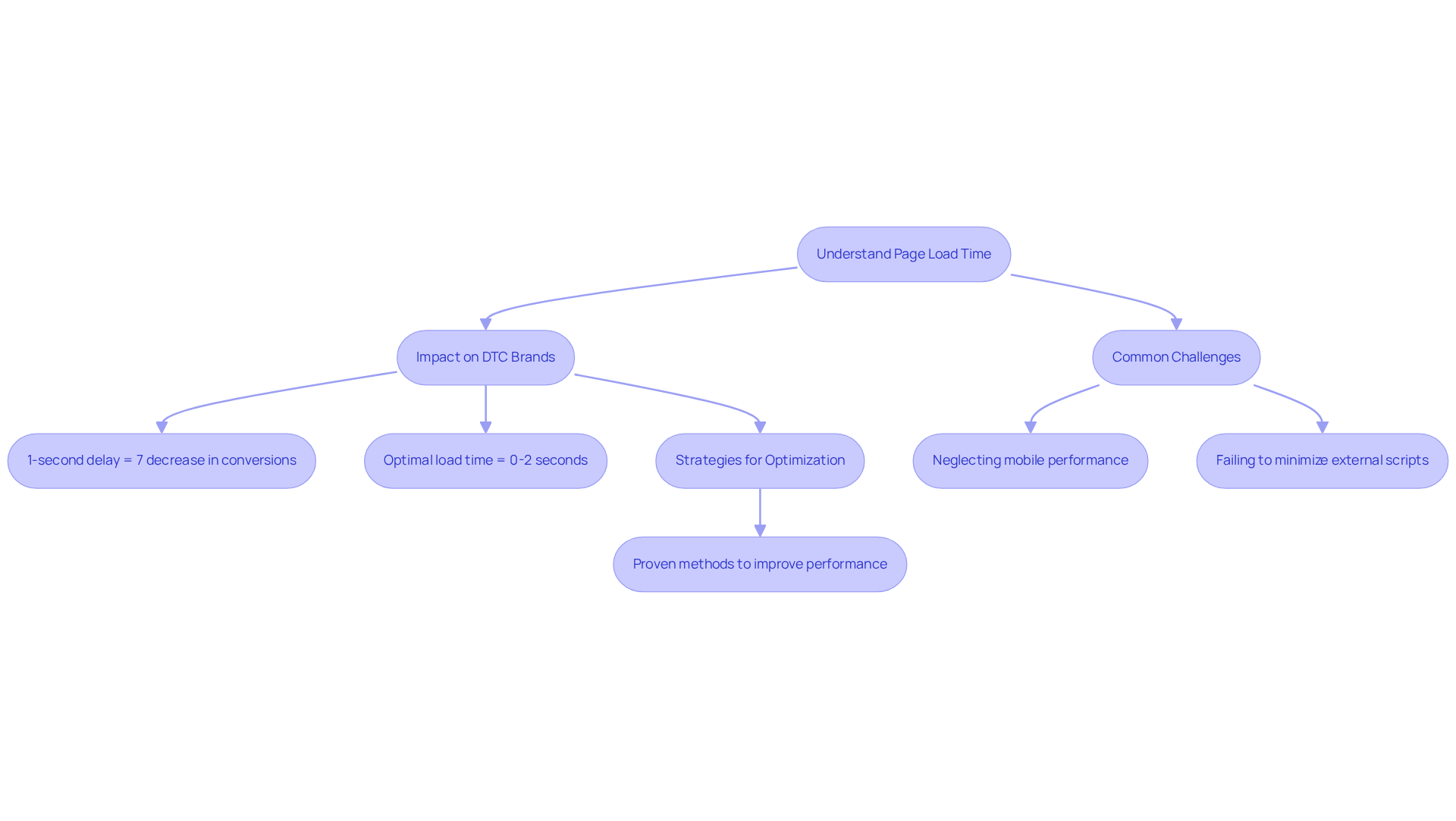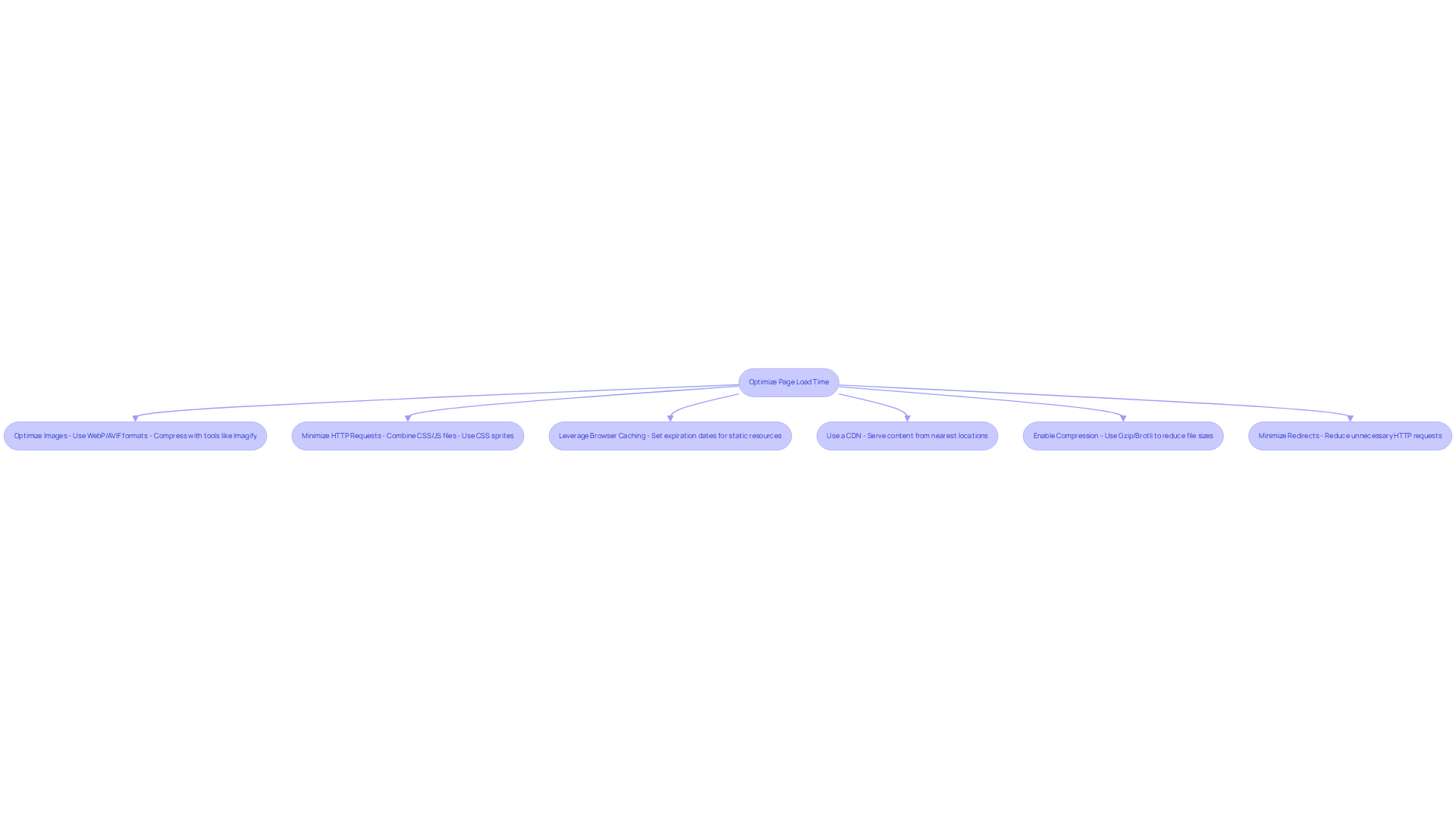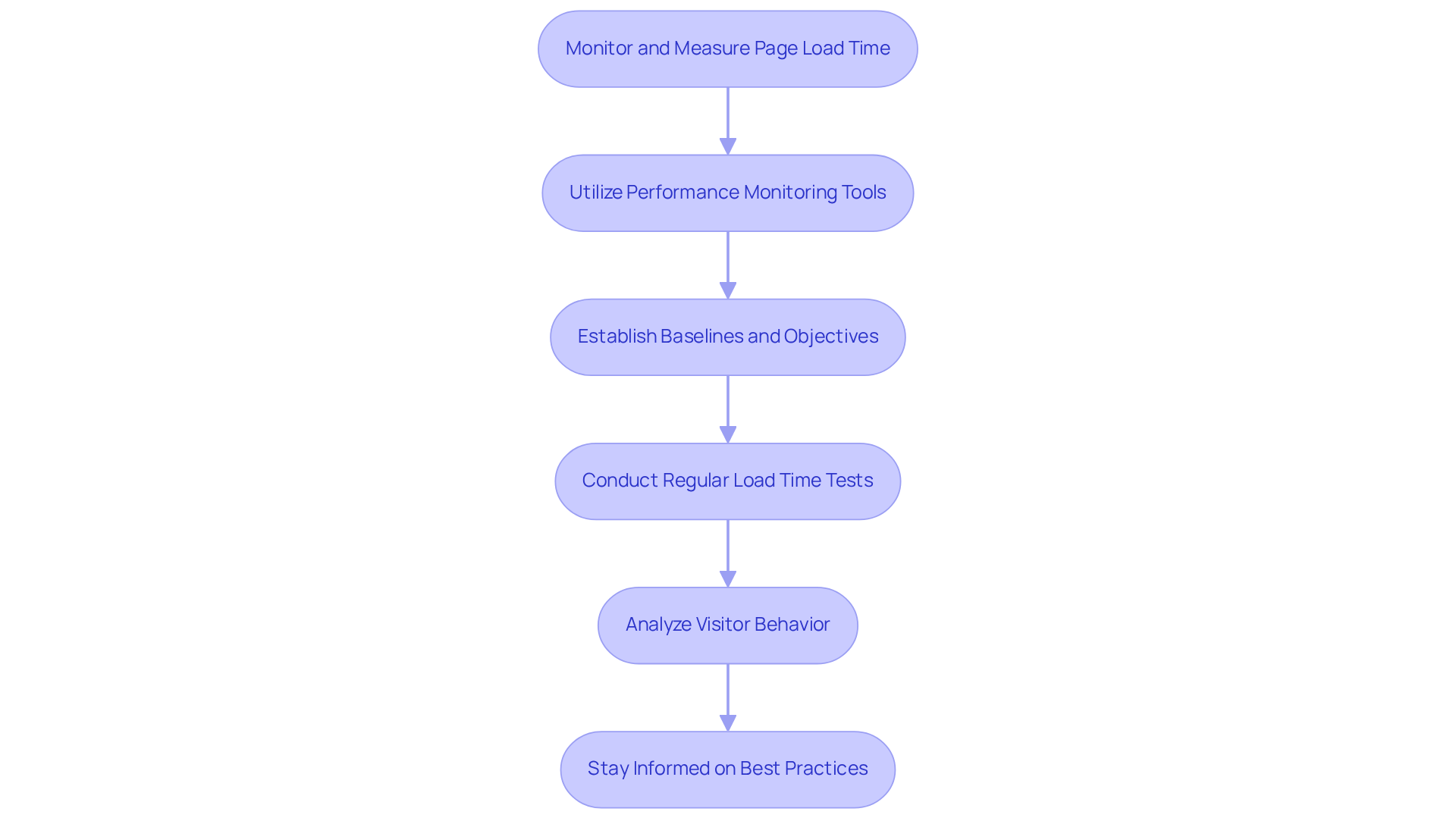
Overview
This article presents essential strategies for optimizing page load time, a critical factor for the success of Direct-to-Consumer (DTC) brands. It asserts that enhancing load times is not merely beneficial but vital; improved load times can dramatically elevate user experience and conversion rates. Data underscores this assertion, revealing that even a one-second delay can result in a 7% decrease in conversions. Thus, optimization emerges as a fundamental requirement for e-commerce growth. By prioritizing page load time, DTC brands can position themselves for significant competitive advantage.
Introduction
Understanding the intricacies of page load time is paramount for direct-to-consumer (DTC) brands striving for success in a competitive digital marketplace. Research reveals that even a one-second delay can result in a staggering 7% drop in conversions; thus, the stakes have never been higher. This article delves into essential strategies that enhance load speeds, improve user experience, and drive sales. As brands navigate the complexities of optimization, they must confront the pressing question: What are the most effective tactics to ensure that every millisecond counts in capturing and retaining customers?
Understand Page Load Time and Its Importance for DTC Brands
The load time page signifies the duration it takes for a webpage to fully load and become interactive for users. This metric is particularly crucial for DTC brands; research indicates that a mere . Notably, the highest e-commerce conversion rates are observed on pages with load times between 0 and 2 seconds, underscoring the imperative for optimization. Enhanced performance not only elevates user experience but also drives greater engagement and boosts sales.
In the current digital landscape, where 79% of consumers who encounter site performance issues are unlikely to return, understanding and improving page speed is not merely beneficial—it is essential for survival and growth in the e-commerce arena.
[Parah Group](https://parahgroup.com), as an authority in Conversion Rate Optimization (CRO), focuses on strategies that not only improve performance speeds but also promote sustainable growth and profitability for DTC companies.
Common challenges in optimizing load time page include:
- Neglecting mobile performance
- Failing to minimize external scripts
Both of which can significantly hinder loading speed. By addressing these challenges, brands can implement proven strategies to enhance their overall performance and profitability.

Identify Key Factors Affecting Page Load Time
Several key factors significantly influence page load time, including:
- Image Size and Optimization: Large images can considerably hinder loading speeds, often representing approximately 50% of a webpage's overall payload. Brands must utilize modern compressed formats like WebP or AVIF, ensuring images are appropriately sized to enhance speed without sacrificing quality.
- Server Response Duration: The interval required for a server to reply to a request is crucial. The ideal server response duration for e-commerce websites should be under 200 milliseconds. Contextually, the average website response duration in 2023 is 2.5 seconds on desktop and 8.6 seconds on mobile. This highlights the significance of enhancing server efficiency through effective hosting solutions to significantly improve response durations.
- Number of HTTP Requests: Each element on a page—images, scripts, and stylesheets—requires a separate HTTP request. Reducing the number of these requests by merging files and minimizing the use of unnecessary plugins can lead to quicker access times.
- Browser Caching: Utilizing allows returning visitors to access pages more quickly by storing certain elements locally. Configuring suitable cache headers for images can result in considerable performance enhancements and decrease server strain, greatly improving user experience and retention.
- Content Delivery Network (CDN): Employing a CDN places content nearer to users, decreasing latency and enhancing retrieval durations. CDNs store content on servers situated worldwide, ensuring that users enjoy quicker access speeds regardless of their location. This is especially advantageous for DTC companies aiming to improve user experience and conversion rates.

Implement Proven Strategies to Optimize Page Load Time
To enhance load time page, DTC brands can adopt several proven strategies that are essential for optimizing user experience and boosting conversion rates.
- Optimize Images: Utilizing modern formats like WebP and employing not only reduces file sizes but also maintains quality. Tools such as Imagify can streamline this process, significantly enhancing speed. It is noteworthy that images account for over 50% of the data downloaded on an average webpage, making their optimization critical for performance.
- Minimize HTTP Requests: By combining CSS and JavaScript files, brands can decrease the number of requests made by the browser. Implementing CSS sprites further streamlines image loading by merging multiple images into a single file, leading to faster page rendering.
- Leverage Browser Caching: Setting expiration dates for static resources allows browsers to cache them effectively. This method reduces wait times for returning visitors, ultimately improving their experience and engagement.
- Use a Content Delivery Network (CDN): Implementing a CDN ensures that content is served from locations closer to the user, thereby decreasing latency and enhancing speed. This approach is particularly beneficial for e-commerce sites with a global audience, as it allows for a more responsive experience.
- Enable Compression: Utilizing Gzip or Brotli compression significantly reduces the size of files sent from the server. This results in quicker access speeds, as smaller files require less bandwidth and processing time.
- Minimize Redirects: Each redirect generates additional HTTP requests, which can hinder loading speeds. Therefore, minimizing the use of redirects is crucial for maintaining optimal performance.
By employing these tactics, companies can achieve notable enhancements in load time page speed, which is essential for increasing user satisfaction and elevating conversion rates. As Mandie Sellars emphasizes, 'Google has verified on multiple occasions that page speed is a crucial ranking element, favoring sites with strong Core Web Vitals.' Furthermore, case studies such as Molekule's, which experienced a 75% increase in device conversion rate after replatforming to Shopify, underscore the tangible benefits of prioritizing website speed.

Monitor and Measure Page Load Time for Continuous Improvement
To ensure the ongoing optimization of page load time, DTC brands must adopt the following strategies:
- Utilize : Leverage tools such as Google PageSpeed Insights, GTmetrix, and Pingdom to gain insights into response durations and identify areas for improvement. These tools analyze performance across various devices and locations, providing a comprehensive view of user experience.
- Establish Baselines and Objectives: Identify baseline performance metrics and set specific, measurable targets for enhancement. A good website performance speed, or load time page, is typically around 2 to 3 seconds for page retrieval, serving as a standard for companies. This method enables efficient monitoring of progress and informed adjustments to strategies.
- Conduct Regular Load Time Tests: Implement a routine testing schedule to uncover new issues that may arise from changes in website content or structure. Regular assessments are essential for maintaining optimal performance and proactively addressing potential bottlenecks that could affect load time page. As Google emphasizes, "Regularly testing your website’s speed is essential."
- Analyze Visitor Behavior: Utilize analytics to examine how load times impact visitor behavior and conversion rates. Understanding these dynamics empowers companies to make data-informed choices that enhance user experience and optimize load time page, which in turn drives sales.
- Stay Informed on Best Practices: The digital landscape is ever-evolving, making it crucial for brands to stay updated on the latest optimization techniques. Continuous learning and adaptation are key to maintaining high performance and competitiveness in the market. Brands should also be aware of common pitfalls, such as the impact of third-party scripts on website speed, which can result in a longer load time page.

Conclusion
Optimizing page load time is not merely a technical necessity; it is a critical component for the success of DTC brands in an increasingly competitive e-commerce landscape. By enhancing load speeds, brands can significantly improve user experience, engagement, and ultimately, conversion rates. The importance of swift page loading cannot be overstated; even slight delays can lead to substantial losses in sales and customer loyalty.
Throughout this article, we have discussed key strategies for optimizing page load time, including:
- Image optimization
- Reducing HTTP requests
- Utilizing browser caching
- Implementing content delivery networks (CDNs)
Each of these tactics plays a vital role in enhancing website performance. Furthermore, the significance of monitoring and measuring load times has been emphasized, ensuring that brands can continuously improve and adapt to the evolving digital environment.
In conclusion, the urgency for DTC brands to prioritize page load speed is unmistakable. By implementing proven strategies and utilizing performance monitoring tools, brands can not only enhance user satisfaction but also gain a competitive edge in the market. Embracing these practices is essential for sustainable growth and profitability, making it imperative for brands to take action now to optimize their web performance and drive success.
Frequently Asked Questions
What is page load time and why is it important for DTC brands?
Page load time is the duration it takes for a webpage to fully load and become interactive for users. It is crucial for DTC brands because a one-second delay can lead to a 7% decrease in conversions, and optimal load times (between 0 and 2 seconds) correlate with the highest e-commerce conversion rates.
How does page load time affect user experience and sales?
Enhanced page load time improves user experience, leading to greater engagement and ultimately boosting sales. A fast-loading page encourages users to stay longer and interact more with the content.
What percentage of consumers are unlikely to return after encountering site performance issues?
79% of consumers who experience site performance issues are unlikely to return, highlighting the importance of optimizing page speed for customer retention.
What are common challenges in optimizing page load time?
Common challenges include neglecting mobile performance and failing to minimize external scripts, both of which can significantly hinder loading speed.
What strategies can DTC brands use to improve page load time?
DTC brands can implement proven strategies to enhance performance by addressing challenges such as optimizing mobile performance and reducing the number of external scripts used on their websites.
Who is Parah Group and what do they focus on?
Parah Group is an authority in Conversion Rate Optimization (CRO) that focuses on strategies to improve performance speeds and promote sustainable growth and profitability for DTC companies.
FAQs











